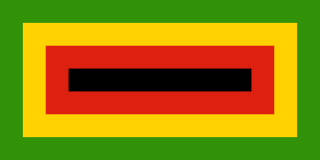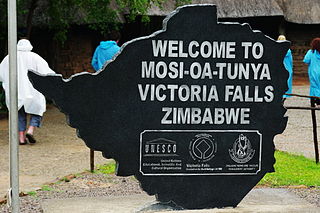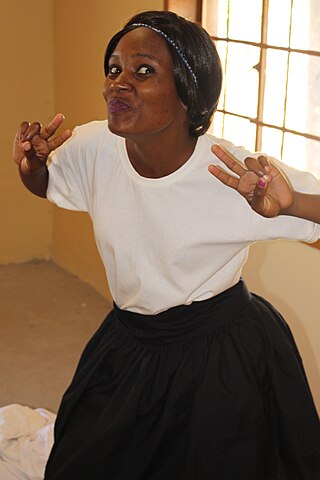
Demographic features of the population of Zimbabwe include population density, ethnicity, education level, health of the populace, economic status, religious affiliations and other aspects of the population. Hizbul Isl
The Gukurahundi was a series of mass killings and genocide in Zimbabwe which were committed from 1983 until the Unity Accord in 1987. The name derives from a Shona language term which loosely translates to "the early rain which washes away the chaff before the spring rains".

Great Zimbabwe was a city in the south-eastern hills of the modern country of Zimbabwe, near Masvingo. It was settled from 1000 AD, and served as the capital of the Kingdom of Zimbabwe from the 13th century. It is the largest stone structure in precolonial Southern Africa. Construction on the city began in the 11th century and continued until it was abandoned in the 16th or 17th century. The edifices were erected by ancestors of the Shona people, currently located in Zimbabwe and nearby countries. The stone city spans an area of 7.22 square kilometres (2.79 sq mi) and could have housed up to 18,000 people at its peak, giving it a population density of approximately 2,500 inhabitants per square kilometre (6,500/sq mi). The Zimbabwe state centred on it likely covered 50,000 km². It is recognised as a World Heritage Site by UNESCO.

Ubuntu describes a set of closely related Bantu African-origin value systems that emphasize the interconnectedness of individuals with their surrounding societal and physical worlds. "Ubuntu" is sometimes translated as "I am because we are", or "humanity towards others". In Xhosa, the latter term is used, but is often meant in a more philosophical sense to mean "the belief in a universal bond of sharing that connects all humanity".
Terence "Terry" Osborn Ranger was a prominent British Africanist, best known as a historian of Zimbabwe. Part of the post-colonial generation of historians, his work spanned the pre- and post-Independence (1980) period in Zimbabwe, from the 1960s to the present. He published and edited dozens of books and wrote hundreds of articles and book chapters, including co-editing The Invention of Tradition (1983) with Eric Hobsbawm. He was the Rhodes Professor of Race Relations at the University of Oxford and the first Africanist fellow of the British Academy.

Zimbabwe has many different cultures, which may include beliefs and ceremonies, one of them being Shona. Zimbabwe's largest ethnic group is Shona.
The 5th Brigade is an infantry brigade of the Zimbabwe National Army (ZNA). The 5th Brigade was created in 1981 from three former battalions of the Zimbabwe African National Liberation Army (ZANLA). It later incorporated over 3,000 ex-ZANLA guerrillas from various units. The brigade was based in Gweru and participated in the Mozambican Civil War as well as a genocide known as the Gukurahundi which targeted Ndebele civilians and Zimbabwe People's Revolutionary Army (ZIPRA) guerrillas.
The British diaspora in Africa is a population group broadly defined as English-speaking people of mainly British descent who live in or were born in Sub-Saharan Africa. The majority live in South Africa and other Southern African countries in which English is a primary language, including Zimbabwe, Namibia, Kenya, Botswana and Zambia. Their first language is usually English.

The Rhodesian Bush War, also known as the Rhodesian Civil War, Second Chimurenga as well as the Zimbabwe War of Independence, was a civil conflict from July 1964 to December 1979 in the unrecognised country of Rhodesia.

The Shona people, formerly known as the Karanga are a Bantu ethnic group native to Southern Africa, primarily living in Zimbabwe where they form the majority of the population, as well as Mozambique, South Africa, and a worldwide diaspora. There are five major Shona language/dialect clusters: Manyika, Karanga, Zezuru, Korekore, Kalanga, and Ndau.

Zimbabwe African National Liberation Army (ZANLA) was the military wing of the Zimbabwe African National Union (ZANU), a militant African nationalist organisation that participated in the Rhodesian Bush War against white minority rule of Rhodesia.
Solomon Mangwiro Mutswairo, also spelt Mutsvairo, was a Zimbabwean novelist and poet. A member of the Zezuru people of central Zimbabwe, he wrote the first novel in the Shona language, Feso.

Nkayi is a district in Matabeleland North, Zimbabwe, about 100 km (62 mi) west of Kwekwe and 168 km (104 mi) northeast of Bulawayo in Nkayi communal land. It is believed that its name originates from the Tonga word "Uyinkayi" meaning "where are you going". The main language spoken is Ndebele.

Gokwe South District is one of the eight administrative districts of the Midlands Province of Zimbabwe. The district administrative seat is located in Gokwe Town also known as Gokwe Centre and the District Administrator is the focal person in terms of all district administrative matters. The district is divided into two administrative entities under the Ministry of Local Government, Public Works and National Housing, which are Gokwe South Rural District Council and Gokwe Town Council. The two district administrative entities were legally setup under the Urban Councils Act of 2015 [Chapter 29:15] and Rural District Councils Act [Chapter 29:13] under the constitution of Zimbabwe. The district is further subdivided into 01 senatorial constituency, 05 parliamentary constituencies and 33 council wards. These constituencies and wards are shared between these two administrative entities of Gokwe South District. According to the 2012 ZIMSTAT National Census Statistics the population of the district was at 330 036 people. Gokwe district is in the north-western part of Zimbabwe its average temperature vacillates at 40 degrees Celsius. Gokwe South District shares its boundaries with 06 districts, namely Binga District, Nkayi District, Kwekwe District, Kadoma District, Lupane District and Gokwe North District.

Many languages are spoken, or historically have been spoken, in Zimbabwe. Since the adoption of its 2013 Constitution, Zimbabwe has 16 official languages, namely Chewa, Chibarwe, English, Kalanga, Koisan, Nambya, Ndau, Ndebele, Shangani, Shona, sign language, Sotho, Tonga, Tswana, Venda, Xhosa. The country's main languages are Shona, spoken by over 70% of the population, and Ndebele, spoken by roughly 20%. English is the country's lingua franca, used in government and business and as the main medium of instruction in schools. English is the first language of most white Zimbabweans, and is the second language of a majority of black Zimbabweans. Historically, a minority of white Zimbabweans spoke Afrikaans, Greek, Italian, Polish, and Portuguese, among other languages, while Gujarati and Hindi could be found amongst the country's Indian population. Deaf Zimbabweans commonly use one of several varieties of Zimbabwean Sign Language, with some using American Sign Language. Zimbabwean language data is based on estimates, as Zimbabwe has never conducted a census that enumerated people by language.

The Kalanga or BaKalanga are a southern Bantu ethnic group mainly inhabiting Matebeleland in Zimbabwe, northern Botswana, and parts of the Limpopo Province in South Africa.

Gokwe North District is the northern of two administrative districts in the Gokwe region of the Midlands province of Zimbabwe. Its administrative seat is Nembudziya.

The Sena people are a Bantu ethnolinguistic group with origins in northwestern region of Mozambique, Sofala Province and Zambezia Province. They are also found in Malawi and Zimbabwe near their respective borders with Mozambique.
Traditional leaders play many roles in Zimbabwean communities, culture and families. They help to promote and uphold cultural values, facilitate development and resolving of disputes in their communities. The institution of traditional leadership is regulated and monitored within the parameters of the Constitution of Zimbabwe. These leaders are put in position by the government of Zimbabwe to work with the people. A chief is not elected into office by popular vote, but through lineage, and is thus in office for life.
Zimbabwean English is a regional variety of English found in Zimbabwe. While the majority of Zimbabweans speak Shona (75%) and Ndebele (18%) as a first language, standard English is the primary language used in education, government, commerce and media in Zimbabwe, giving it an important role in society. Just under 5 percent of Zimbabweans are native English speakers and 89 percent of the population can speak English fluently or at a high level, second only to the Seychelles amongst African nations.











